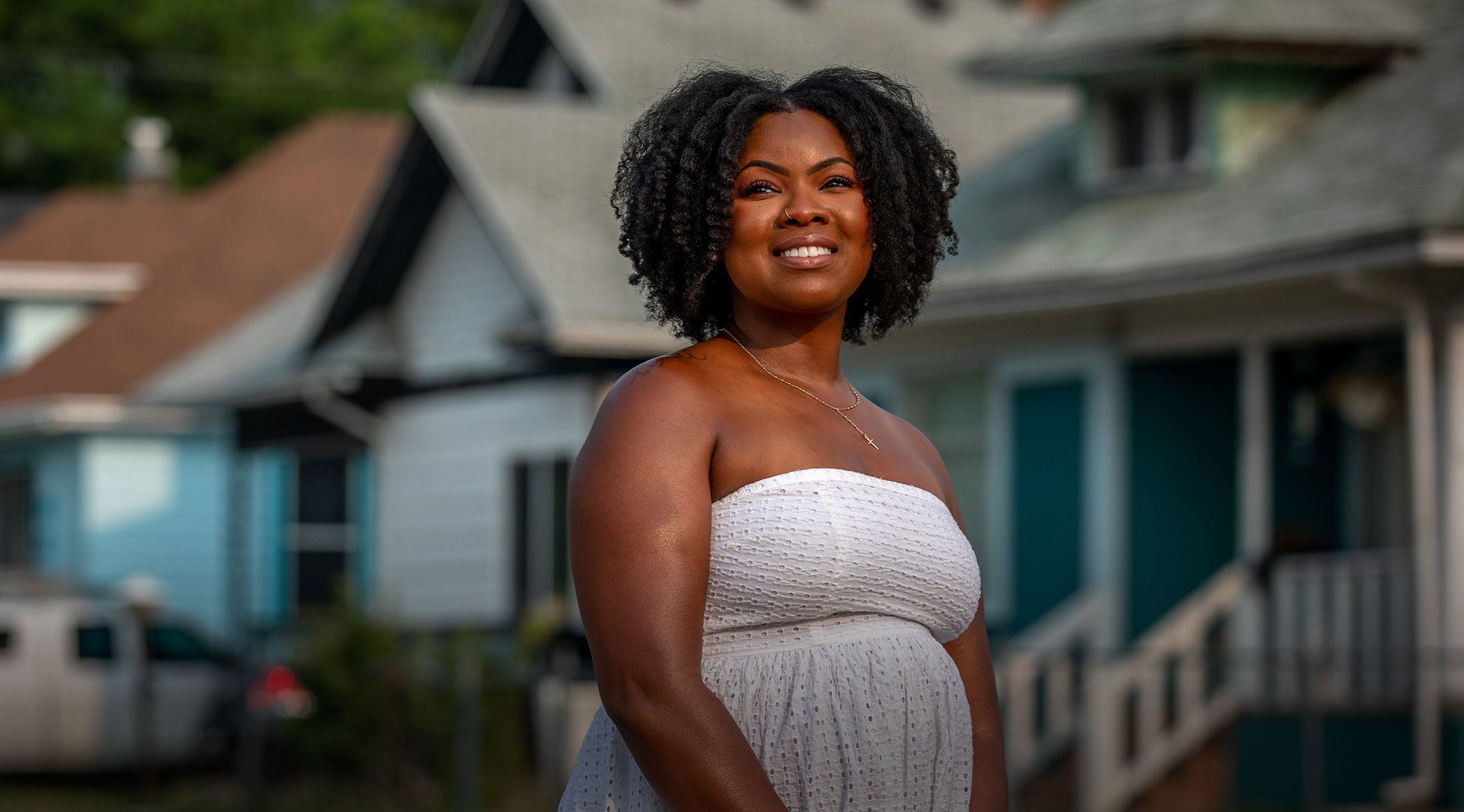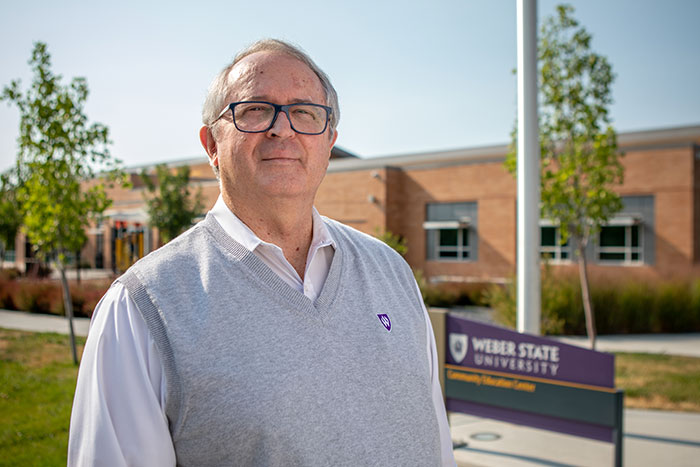
Creating Connections to Care
At the height of COVID-19, WSU and Ogden community leaders banded together for residents lacking healthcare.
Jaime Winston, Marketing & Communications
Two things drive Shardae Jones’ commitment to helping people access healthcare: her experiences at work and growing up.
At work, Jones has seen the struggles those with limited access to care face daily due to lack of income, lack of insurance, homelessness, language barriers and more.
Jones recently started a position as the Communities that Care (CTC) specialist for the Ogden-Weber Community Action Partnership (OWCAP) in Roy, Utah, where she is part of a team that connects volunteers with local schools to educate students about preventing suicide, substance abuse and creating positive relationships at home and in school. Prior to this role, she worked for the Association for Utah Community Health (AUCH), where she connected patients in Weber County facing healthcare barriers to sustainable, long-term care. The Alliance for the Determinants of Health, an organization dedicated to combating non-medical issues that impact health, looked to Jones and her colleagues to help address those issues as well. Patients she worked with were referred by Select Health and local health organizations like Midtown Community Health Center.
Jones worked with her clients for up to six months.

“I’m not any better than them. I work here, I’ve gone to school here, I’m involved in the community here, I’ve walked the streets here, I live here... I am them,” Jones, a lifelong Ogdenite, said about her clients.
Growing up, she said her parents struggled with drugs, alcohol and rehab stints. She and two of her three siblings lived with her grandparents for a time, and she moved often, since the family struggled to afford housing. To this day, Jones worries about her mother’s ability to afford healthcare.
“My mom is a felon, a three-time felon,” Jones said. “So, it’s hard for her to find jobs, it’s really hard for her to keep jobs.”
At AUCH, Jones worked with people in similar situations to her mother, who also has a chronic health condition and recently had open-heart surgery.
“I know how difficult it is to navigate [the healthcare system] if you don’t have someone who is willing to help you,” she said.
As a 32-year-old, non-trad WSU student, she is earning her Bachelor of Integrated Studies in criminal justice, communication and health administration to one day help others at an administrative level.
Jones isn’t alone in wanting to address health inequities.
She recently joined other Ogden community members in the COVID-19 Multicultural Task Force for Ogden City.
Community leaders created the task force following a presentation Nubia Péna, director of the Utah Division of Multicultural Affairs, gave to the Ogden City Council and Ogden Diversity Commission, outlining urgent healthcare needs for local communities.
“We kind of just started thinking about various groups and leaders in our community who could band together,” said Taylor Knuth BA ’14, founding task force member and former WSU development director.
The task force included 28 community leaders and many volunteers, including WSU staff, faculty, alumni and students like Jones.
The task force set out to increase healthcare access for underserved, underrepresented and historically marginalized communities, a need also pointed out by Weber State’s Center for Community Engaged Learning Research Extension (CCEL-RE).
At the height of the pandemic, CCEL-RE, an office created to meet community data and research needs, launched an online dashboard, pulling together data from public sources and community partners to show how the pandemic impacted Weber County.
The dashboard features charts and graphs regarding hospitalizations, unemployment rates, evictions and more.
When it went online in February 2021, Weber County residents who were American Indian or Native Alaskan were four times as likely to be hospitalized due to COVID-19, compared to those identifying as white, while Hispanic/Latinx residents were three times as likely to be hospitalized. Hospitalizations rose in April 2020 for all COVID-19 patients, but Spanish speakers accounted for a disproportionate number of hospitalizations.
As of April 2021, the percentage of total cases that resulted in hospitalizations for Spanish speakers (3.1%) was twice that of English speakers (1.6%). In July 2021, the percentage of residents identifying as American Indian/Alaska Native, Black/African American and Native Hawaiian/Pacific Islander who were vaccinated was lower than other races and ethnicities.
Much of the disparities stemmed from barriers to accessing care.
“Testing was a huge issue,” Knuth said. “People of color were underrepresented in all of the numbers. So, not only were they having higher infection rates but they weren’t getting tested, so it’s possible those infection rates were way higher than what was reported.”
Partnering with Intermountain Healthcare for a testing clinic in November 2020, the task force helped set an Intermountain Healthcare record for the most tests administered at a single event: 564 in four hours. The task force, which operated from April to December 2020, held six other testing clinics, along with a free flu vaccination clinic thanks to a $25,000 state grant.
“One of the efforts was making sure we were communicating in the languages of the communities that were being impacted heavily, so we ensured there was Spanish translation of this information that was coming out,” said Angela Choberka MA ’11, task force member and Member Equity Program consultant at SelectHealth.
Realizing CDC health guidance was being disseminated rapidly by local organizations with little to nothing provided in Spanish, the task force lobbied local health organizations to dedicate Spanish-language resources. Ogden City Council allocated $30,000 for translation services. Weber County and Weber-Morgan Health Department also made it a priority.
The task force also partnered with A Mask for Every Utahn to distribute over 60,000 masks, handing them out at a wide range of locations, from Walmart to Rancho Markets to the Ogden Intermodal Transit Center.
For children in the Ogden School District learning at home, the task force prepped over 1,500 art kits, with crayons and scissors.
Jones found out about the task force from Choberka, a coordinator for the Alliance for the Determinants of Health.
“I wanted to get more involved in what was going on in the city and the county,” Jones said. “So, she just gave me the information and then I just started joining the meetings.”
Jones recalls screening people receiving COVID-19 tests at Odyssey Elementary. Some were appreciative, some didn’t like having to wear a mask in line, and a few mistakenly thought it would be a drive-through clinic and didn’t dress for the cold day. While lessons were learned for the next clinic, she knows she made a difference.
After working with community leaders in the task force, she’s considering one day running for city council. Recently, she accepted a position on the Ogden City Diversity Commission.
“It’s just pushed me to see my greater responsibility — doing what I can to make where I live a better place and somewhere other people want to live,” Jones said. “I’ve been really blessed, but not everybody’s in the same position, so I just want to be able to give back in some way.”
Further Research
Local health, advocacy and educational resources
OgdenCAN Meets an Ongoing Need
Bill Cook proudly served on the Multicultural Task Force.
After all, the group’s goals dovetail with his ongoing mission as Ogden Civic Action Network (OgdenCAN) director.
 Part of WSU’s Office of Community Development, OgdenCAN brings together seven local institutions to address health, education, housing and financial stability for nearly 14,000 residents in Ogden’s East Central neighborhood. Participating organizations include Ogden City, local health organizations and more.
Part of WSU’s Office of Community Development, OgdenCAN brings together seven local institutions to address health, education, housing and financial stability for nearly 14,000 residents in Ogden’s East Central neighborhood. Participating organizations include Ogden City, local health organizations and more.
“It’s probably over 14,000 reasons why people have health issues,” Cook said. “However, poverty does contribute to that, lack of healthcare access contributes to that, intergenerational poverty contributes to that as well.” About 30% of the residents are in poverty, and about 70% don’t earn a living wage, he said.
OgdenCAN’s projects in the community have included working with Ogden School District and Ogden-Weber Technical College to provide paths to adult high school diplomas and GEDs, implementing a program for physicians to prescribe free produce at grocery stores for those facing food insecurity; and piloting a rideshare program for doctor visits.
“This particular neighborhood has so many incredible assets,” Cook said. “The people are so resilient; it’s been quite amazing getting to know people.”
OgdenCAN recently published a wellness guide, featuring inexpensive or free health resources, and started a community leaders program where five interns are hired from the neighborhood each year to complete community projects.
Cook invites anyone interested in volunteering to reach out.
